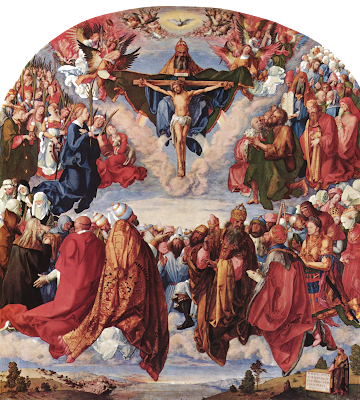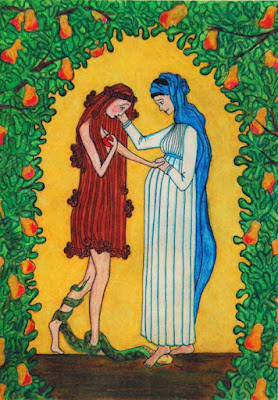The holiness challenge.
November 1 2019: Solemnity of All Saints
An American proverb says, “It is a man's challenge to go as
far as he can on the right road.”
Life is made of challenges. Christian life the more, is a
challenge to holiness. God created us “very good” (Gn 1:31), and we are called
to perfection. Our vocation, the finality of our existence is to be in the Glory
of God, that is to live and be with God. St. Augustine could therefore affirm in
his Confessions, “You have made us for Yourself, and our hearts are restless
until they rest in You.” We are actually created to be in God.
The Catechism of the Catholic Church in its article 2013
states, “All Christians in any state or walk of life are called to the fullness
of Christian life and to the perfection of charity." All are called to
holiness: "Be perfect, as your heavenly Father is perfect."” Then, it
carries on showing the way to attain that perfection. It says, “In order to
reach this perfection the faithful should use the strength dealt out to them by
Christ's gift, so that . . . doing the will of the Father in everything, they
may wholeheartedly devote themselves to the glory of God and to the service of
their neighbor. Thus, the holiness of the People of God will grow in fruitful
abundance, as is clearly shown in the history of the Church through the lives
of so many saints.”
We are celebrating today, with great solemnity, the All
Saints Day. What we celebrate is not merely the merits of some people who have
reached holiness through some specific way of life. Rather, it is the challenge
opened to us to be holy. Far from being a memorial or a reminiscence of the
life of Saints, this solemnity sets us in the present and renews to us the obligation
to be saints: “Be perfect, as your heavenly Father is perfect.” It is actually
the feast of the universal call to holiness in our today’s world, as Pope Francis
affirmed in his Apostolic Exhortation “Gaudete et Exsultate.” The Lord “wants
us to be saints and not to settle for a bland and mediocre existence.” GE. 1
While in the first reading, John, through an apocalyptic vision, presents
us the picture of a great multitude of people which no one could count, from
every nation, race, people and tongue, in the second reading, the same Apostle John
tells us that we too, "shall see God as he is". But how will it be possible for
us to see God? The answer can be found in the Gospel: through living in the way
of the Beatitudes.
The Beatitudes actually, are the road map to holiness. We learn
from them that holiness consists not in great and unreachable things, but in
some few little acts. They mostly teach how to go the right way in a wrong way
world. More than just being some good principles of life, the Beatitudes teach
us the way of God and the way to God; that is, how does God see and intend our
life to be. They also provide us with new and more authentic definition of
happiness and blessing. And finally, one could say, the Beatitudes are a
counter flow of the world’s philosophy.
The Lord, in the sermon of the Mountain tells us that to be
holy today, one only needs to be poor in spirit, to mourn, be meek, hunger and
thirst for righteousness, be merciful, be clean of heart, be peacemakers,
accept to be persecuted for the sake of righteousness and accept all kind of insults
for his name sake. That, actually, opposes the way of the world. Because, the
world teaches us that happiness and blessing reside in material possession and
accumulation. Jesus, instead, teaches his followers that genuine happiness lies
in possessing God alone. While the way of the world opens us to individualism
and self-centeredness, the way of Jesus, the Beatitudes, leads to others-centeredness.
With Jesus, we learn to make of others the center of our life, feeling more
preoccupied for their cause than for our own.
Holiness is an opportunity offered to you and I today to challenge
and change our way looking at life and at others. The example of some forerunners
of the race to sainthood can always inspire and encourage us. Through their
life, we clearly learn that holiness is not a predestination. It is not that
some people are born with a DNA in which it is inscribed ‘going to be saint’. The
saint is the “next door” neighbor, that is another me with another name. The
question is, how like him or them we too could become what they are today. Looking
to the example of some saints like Francis of Assisi, Padre Pio, Josemaría
Escrivá de Balaguer y Albás, Luigi Orione, Teresa of the Child Jesus, Mother
Teresa of Calcutta, or John Paul II…, we could ask, what did they do to become
saints? How special was their life? And what do we have to do to be like them?
Actually, the life of those Saints shows that they did
nothing than being humans, and fully humans. Because Sainthood is for people
who are humans. Having the legs and hands on earth and the heart turned toward
God, they felt the need of people and with the little they had, they tried to
answer to those needs. Some of them, even had nothing, but their life to give,
and they gave it as sacrifice to serve and love the neighbor.
To be holy does not require great miracles. But
rather to live in an extraordinary way the ordinary of our life. In this sense,
the suggestions of the Beatitudes will always resound in our hearts: humility,
simplicity, openness to others, patience, courage ... To be holy today is to
cultivate a habitual and firm disposition to do good, whatever the cost.





Comments
Post a Comment